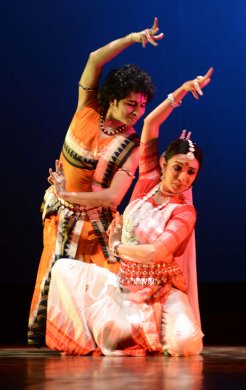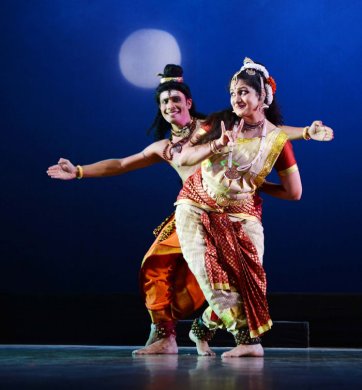
|   |

|   |
Natyalakshana's trio natya - Ashish Mohan Khokar e-mail: khokar1960@gmail.com Photos: Srivatsa June 29, 2014 Usha Venkateshwaran is a senior dance teacher, choreographer and promoter. Married to one of India’s finest IFS talents, former Foreign Secretary A.P. Venkateswaran, she settled in Bangalore after globetrotting the world over. She has now taken over to present budding and established talents in need of good platforms. Thus she presented three dance pairs in three forms: Odissi (Sharmila Mukerjee and Arnab Mukherjee), Contemporary (Chitra Arvind and Raam Kumar) and Bharatanatyam (Seshadri Iyengar and Shama Krishna).  Arnab Mukherjee & Sharmila Mukerjee  Chitra Arvind & Raam Kumar Sharmila and Arnab, undertook the well-known Arjun-Chitrangada tale and acquitted meaningfully. Sharmila controlled her over smiling countenance that usually is pasted on her face in Orissi recitals and this form set to Rabindra Sangeet suited her more. She has a latent tala issue but this piece didn’t call for much intensive dancing of nritta (technique) portions. The sheer softness of Bengali words and sangeet (by the Tagore - no less!), where Arjun called Orjun, was lilting. Arnab Mukherjee shows maturity of form and none of the nambi-pambiness generally seen on Bengal stage. Both have learnt from iconic Kelubabu mould via Ratikant Mohapatra and it was an enjoyable performance, compered by fellow Bengali talent Prabal Gupta, who faltered on many words and mispronounced them (niche, connoisseurs, etc). He also gave instant one line review after each item concluded. Comperes should stick to announcing the matter on hand and not turn instant reviewer or critic on stage. It brings down the level of the show. Let the audience decide if they liked the item or not, a compere need not say “that was a brilliant performance, please clap again!” Next was Spartacus by Chitra Arvind and Raam Kumar, a young lad from the lineage of CVN Kalari tradition. Chitra is a rather stiff dancer and has a hard face for dance but Raam Kumar has loads of dance in his body, suppleness and substance. Thus, Chitra Arvind remained limited, while Raam Kumar clearly was the star of the story of Spartacus. In the end, he also showed his martial skills. Raam Kumar and Arnab Mukherjee proved to be talented, refreshing new faces on the Bangalore stage.  Sheshadri Iyengar & Shama Krishna The last pair was Seshadri Iyengar (the compere kept announcing first name alone, which is disrespectful for stage) and Shama Krishna in Shiva-Parvati routine tale, well danced and well executed. Music by Delhi composer Partho Das was rich. Dr. Iyengar's hastas alone are worth watching as also his feet. But need Shiva smile all through? Why artistes no longer adorn their feet with alta beats me. They cite "costume will be spoilt" as reason! Then why dance with costume as sweat too can spoil it? Dance in home clothes. Alta is not decoration alone but centering of eye on stage. Feet (and palms) from audience eye levels look empty. Most dancers nowadays also wear fewer ghungroos as they can’t dance to proper beat. So the absence of sound helps make up for faulty rhythm. Shama is a sweet looking dancer but does she need to have the same plastic smile all through? In the opening sequence only her back is seen with focused lights and the Bharatanatyam costume on a heavy build is not a pretty sight when seen from behind and the waist covering is short. But this pair was the one with best chemistry and they were involved with their art. Others were uncomfortable in their pairing and looked unsure and reserved. On stage everything gets magnified, remember. On the whole, one went away with the feeling of good dancers, good opportunity and a good audience. Usha Venkateswaran was an epitome of good grace and culture. Lights by Nagaraj was exceptional. Ashish Mohan Khokar is a reputed dance critic and historian, with over 40 published books. He is the inheritor-curator of India’s largest dance archives The Mohan Khokar Collection. He helped revive solo male dancing and mentors many young talents. He devised and conducts regular academic dance discourses for the public and universities of Baroda, Bombay, Bangalore. He Chairs the Dance History Society, which has instituted 5 annual awards with internships abroad in memory of dance greats. For details see attendance-india.com |